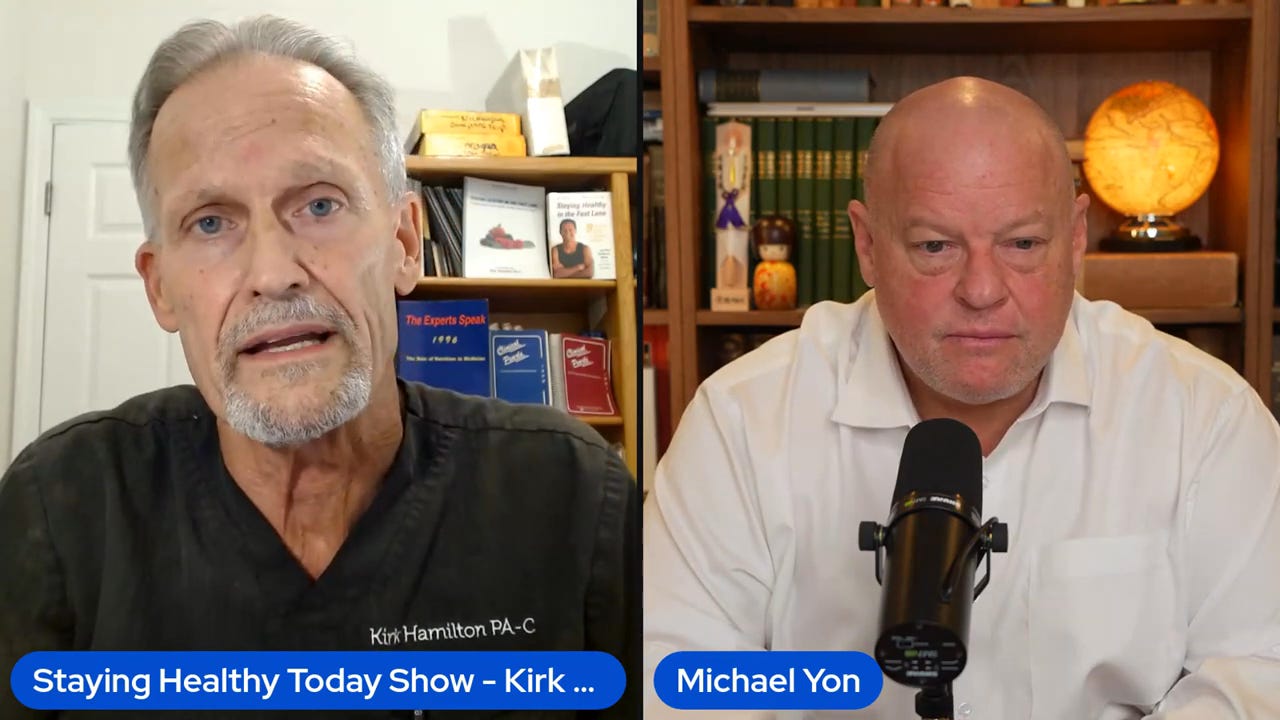Do Patients With Endometriosis Have Impaired Intestinal Permeability Compared to Healthy Controls and Patients with Pelvic Pain Without Endometriosis?
Description
Shanti Mohling, MD, FACOGNorthwest Endometriosis and Pelvic Surgery511 SW 10th Ave, Suite 907, Portland, OR 97205503-715-1377 / Fax 503-715-2717Shantimohling@gmail.com
“Intestinal permeability and endometriosis: a pilot investigation ” Journal of Endometriosis and Uterine Disorders, September 2023, Volume 3,100045 9/2025
Kirk’s Comments on Interview…
Fond Memories of the Power of Food Elimination…I was very excited about this interview because it reinforced a major belief and long-standing practice of mine as an integrative medicine physician assistant: that individual foods—or patterns of food consumption—can cause virtually any symptom, symptom complex, or systemic disease.
This understanding dates back to my very first job as a physician’s assistant in an integrative medicine practice in May 1983, where nearly every patient was placed on a two-week “detox.” The protocol consisted of a green smoothie (with psyllium seed husks and basic vitamins) and daily coffee enemas to “stimulate” liver detoxification. Nothing else was eaten. I remember it well—it was a kind of slimy, green drink.
The bottom line was simple: patients were removed from their usual food patterns. Most patients came in with multiple complaints, often linked to unhealthy diets. Or others ate what seemed like a pristine diet but regularly consumed one or two foods that “looked healthy” but triggered sensitivity—such as eggs, sprouted grain bread, sourdough, yogurt or coffee (it could be any frequently eaten whole food…). One person’s health food could easily be another’s source of chronic symptoms.
In just six months at that practice, I witnessed nearly every patient experience improvements in their symptoms or disease complex during or after this two-week elimination diet. It didn’t matter what their initial complaints were—almost always, something improved.
Working Hypothesis…My working hypothesis is that removing the patients “normal foods” (some offending?) gave the gut time to heal. Most gut cells from the stomach to rectum take somewhere between 3–7 days to regenerate. Intestinal permeability can improve from weeks to months. I suspect that excessive antigen uptake that fuels immune activation was reduced immediately by eliminating commonly eaten offending foods, and, over time as intestinal permeability was reduced. This “quieted” the immune system and lead to symptom relief—sometimes immediately, sometimes after weeks or months on a low “food intolerance” regimen.
The “magic” wasn’t just in food removal; it was in the gut’s opportunity to repair itself. Depending on diet and fiber intake, the microbiome (intestinal bacteria) can take months to re-balance which is where systemic disease can be slowed, stopped or even reversed.
What Do Food Sensitivities or Diet Have to Do with Endometriosis?…This experience is directly relevant to Dr. Mohling’s research. She and her colleagues found a significantly higher degree of intestinal permeability in patients with endometriosis compared to those with pelvic pain alone or healthy controls.
This suggests that food—directly or indirectly, through intestinal permeability and microbiome disruption—“may” play a role in triggering or healing endometriosis (or symptom reduction) in susceptible individuals.
The key question is whether increased intestinal permeability precedes endometriosis or is a consequence of the disease. It may be both: a contributing factor and a byproduct, creating a vicious cycle.
Endometriosis Tissue: Similar but Not the Same…Dr. Mohling explained a compelling hypothesis: that endometrial-like tissue outside the uterus may originate during gestation. This tissue is similar to, but not identical with, uterine endometrial lining. When exposed to inflammatory cytokines, it can become symptomatic endometriosis in and around the abdominal cavity and organs.
Rather than relying solely on the retrograde menstruation theory, this explanation offers a clearer mechanism: physiologic events such as increased intestinal permeability or altered microbiota may drive inflammation that stimulates these ectopic tissues.
Kirk’s “Mile High View”…The bigger picture is that intestinal permeability and microbiome disruption may underlie not only endometriosis but also many chronic systemic illnesses. The specific symptoms differ, but the pathophysiology is similar: food (or medication) consumption → increased intestinal permeability → microbiome disruption → inflammatory mediator release → chronic disease.
So, while Dr. Mohling’s findings are directly relevant to endometriosis, they also apply broadly to many chronic conditions that conventional medicine struggles to manage.
That said, Dr. Mohling is clear: for significant endometriosis, surgery is usually necessary to achieve meaningful symptom relief. Lifestyle measures are supportive but rarely sufficient on their own.
Lifestyle Strategies for Endometriosis…In addition to a whole-food diet rich in fruits, vegetables, protein, and cultured dairy, Dr. Mohling recommends:
* Vitamins C, D, and E
* NAC (N-acetylcysteine)
* Omega-3 fatty acids
* Magnesium
* Probiotics
* Palmitoyl ethanolamide (PEA) — which Dr. Mohling was particularly enthusiastic about
I would also suggest:
* Assessing for bacterial or yeast/fungal overgrowth, or doing a therapeutic antifungal trial over 2-4 weeks if indicated by extensive antibiotic history.
* Incorporating periodic fasting, such as the Prolon Fasting Mimicking Diet (five days a month for 6–12 months) to reduce immune activation and inflammatory mediators.
* Considering supervised water fasting programs at centers like TrueNorth Health Center for carefully selected patients for 1-2 weeks.
Kirk Hamilton PA-C
Otter.AI Generated Interview Transcript Summary
* Overview…Dr. Shanti Mohling, an OB-GYN surgeon, discussed her study on intestinal permeability in patients with endometriosis, published in the Journal of Endometriosis and Pelvic Pain Disorders. The study found that 50% of endometriosis patients had intestinal permeability, compared to none in healthy controls and 10% in those with pelvic pain but no endometriosis. Dr. Mohling emphasized the importance of lifestyle changes, including a diet rich in fruits, vegetables, and lean proteins, and the use of supplements like omega-3, vitamin D, and NAC. She also highlighted the need for surgery to manage endometriosis effectively.
Introduction and Background of Dr. Shanti Mohling…
* Kirk Hamilton introduces himself and the show's focus on endometriosis and intestinal permeability.
* Dr. Shanti Mohling, an OB-GYN surgeon, is introduced as the guest.
* Dr. Mohling shares her background, including her education in massage therapy and her transition to medical school.
* Dr. Mohling discusses her current focus on surgical management of endometriosis in Portland, Oregon.
Understanding Endometriosis and Its Etiology…
* Dr. Mohling explains the etiology of endometriosis, emphasizing that it is not fully understood.
* She describes the theory of retrograde menstruation and the role of unhealthy peritoneal fluid in endometriosis.
* Dr. Mohling highlights the importance of a healthy internal environment in managing endometriosis.
* Kirk Hamilton asks for clarification on endometriosis, and Dr. Mohling explains the process of endometrial tissue possibly migrating outside the uterus and/or the endometrial-like tissue was already present outside the uterus but do to multiple triggering factors caused the manifestation of the disease which could be the result of increased intestinal permeability or the disease process might increase intestinal permeability.
Intestinal Permeability and Endometriosis…
* Dr. Mohling discusses her study on intestinal permeability and endometriosis, noting that half of the patients with endometriosis also had increased intestinal permeability.
* She explains that intestinal permeability can be transient and can improve with dietary changes.
* Dr. Mohling emphasizes the association between intestinal permeability and endometriosis, but not the causality.
* Kirk Hamilton and Dr. Mohling discuss the inflammatory nature of endometriosis and its impact on pain.
Prevalence and Impact of Endometriosis…
* Dr. Mohling estimates that 10% of females have endometriosis, which can range from mild to severe.
* She describes the debilitating effects of endometriosis, including severe dysmenorrhea, infertility, and fibrotic lesions.
* Dr. Mohling explains how endometriosis can manifest with IBS-like symptoms and debilitating cramping pain.
* Kirk Hamilton asks about the symptoms of endometriosis, and Dr. Mohling emphasizes the importance of recognizing severe menst
























